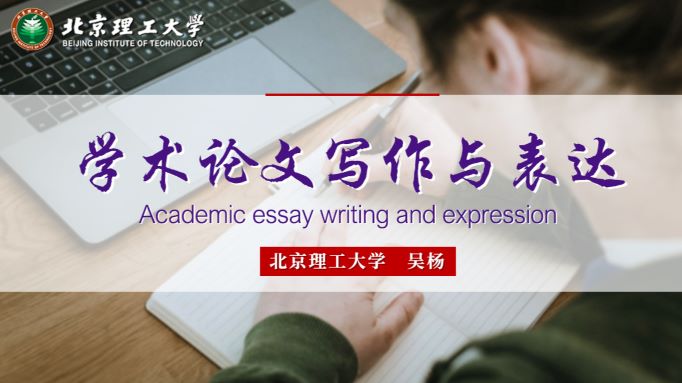
Analytical Chemistry课程:前往报名学习
The online course of analytical chemistry in English is taught by four experienced teachers, covering the main contents of chemical analysis and instrumental analysis. This course features clear knowledge, clear narration, rich pictures and texts, equal emphasis on theory and practice, as well as plenty of classroom quizzes, unit tests, and test questions. —— Course team
开设学校:西安交通大学;学科:理学、
The online course of analytical chemistry in English is taught by four experienced teachers, covering the main contents of chemical analysis and instrumental analysis. This course features clear knowledge, clear narration, rich pictures and texts, equal emphasis on theory and practice, as well as plenty of classroom quizzes, unit tests, and test questions. —— Course team
-2.2-1Systematic and random errors
-2.2-1Systematic and random errors-1
-2.2-2 Systematic and random errors-2
-2.2-2 Systematic and random errors-2
-Discussion for chapter 2
-Quiz for chapter 2
--Quiz for chapter 2
-3.2 Standard solution and primary standard
-3.2 Standard solution and primary standard
-3.3Calculation in titration analysis
-3.3Calculation in titration analysis
-Discussion of chapter 3
-Quiz for chapter 3
--Quiz for chapter 3
-4.1-1Calculation of pH for solutions
-4.1-1Calculation of pH for solutions
-4.1-2Calculation of pH for solutions
-4.1-2Calculation of pH for solutions
-4.3 Titration of strong acid-base
-4.3 Titration of strong acid-base
-4.4 Titration of weak acid-base
-4.4 Titration of weak acid-base
-4.5 Preparation of standard solutions
-4.5 Preparation of standard solutions
-4.6 Application of acid-base titration
-4.6 Application of acid-base titration
-Discussion for chapter 4
-Quiz for chapter 4
--Quiz for chapter 4
-5.1 Overview of complexometric titration
-5.1 Overview of complexometric titration
-5.2 Side reaction coefficient
-5.2 Side reaction coefficient
-5.3 Conditional formation constant
-5.3 Conditional formation constant
-5.4 Coordination titration curve
-5.4 Coordination titration curve
-5.5 Acidity control and calculation
-5.5 Acidity control and calculation
-5.6-1 Principle of metal indicator-1
-5.6-1 Principle of metal indicator-1
-5.6-2 Principle of metal indicator-2
-5.6-2 Principle of metal indicator-2
-5.7 Method for improving the selectivity of coordination titration
-5.7 Method for improving the selectivity of coordination titration
-5.8 Coordination mode and application
-5.8 Coordination mode and application
-Discusion for chapter 5
-Quiz for chapter 5
--Quiz for chapter 5
-Discussion for chapter 6
-Quiz for chapter 6
--Quiz for chapter 6
-6.2 Equilibrium Constant of Redox Reaction
-6.2 Equilibrium Constant of Redox Reaction
-6.5 Detection of the End Point
-6.5 Detection of the End Point
-6.6 Potassium permanganate and potassium dichromate titration
-6.6 Potassium permanganate and potassium dichromate titration
-6.7 Titration with Oxidizing Agents (II) Iodometry
-6.7 Titration with Oxidizing Agents (II) Iodometry
-Discussion for chapter 7
-Quiz for chapter 7
--Quiz for chapter 7
-7.1 Principles of precipitation titration
-7.1 Principles of precipitation titration
-7.2 Potassium chromate indicator
-7.2 Potassium chromate indicator
-7.3 Ferric ammonium sulfate indicator and adsorption indicator
-7.3 Ferric ammonium sulfate indicator and adsorption indicator
-Quiz for Chapter 8
--Quiz for chapter 8
-Discussion for Chapter 8
-8.5 Typical spectrum of the organic compounds and summary
-8.5 Typical spectrum of the organic compounds and summary
-9.1 The generation of fluorescence
-9.1 The generation of fluorescence
-9.2Excitation spectrum and emission spectrum
-9.2Excitation spectrum and emission spectrum
-9.4 Application of fluorescence analysis
-9.4 Application of fluorescence analysis
-Quiz for Chapter 9
--Quiz for Chapter 9
-Discussion for Chapter 9
-Quiz for chapter 10
--Quiz for chapter 10
-Discussion for chapter 10
-10.5 Typical spectrum of the organic compounds and summary
-10.5 Typical spectrum of the organic compounds and summary
-Discussion for chapter 11
-Quiz for chapter 11
--Quiz for chapter 11
-11.1 An Introduction to NMR Spectroscopy
-11.1 An Introduction to NMR Spectroscopy
-11.3 1H NMR Position and Intensity of Signals
-11.3 1H NMR Position and Intensity of Signals
-11.4 1H NMR Spin—Spin of Splitting
-11.4 1H NMR Spin—Spin of Splitting
-11.5 Other Factors About 1H NMR Spectroscopy
-11.5 Other Factors About 1H NMR Spectroscopy
-11.6 Using 1H NMR to Identify an Unknown
-11.6 Using 1H NMR to Identify an Unknown
-12.1 The principles and applications of mass spectrometry
-12.1 The principles and applications of mass spectrometry
-12.3-1 Mass spectrum and ion peak type-1
-12.3-1 Mass spectrum and ion peak type-1
-12.3-2 Mass spectrum and ion peak type-2
-12.3-2 Mass spectrum and ion peak type-2
-12.3-3 Mass spectrum and ion peak type-3
-12.3-3 Mass spectrum and ion peak type-3
-Discussion for chapter 12
-Quiz for chapter 12
--Quiz for chapter 12
-13.2 Atomic absorption spectrophotometer
-13.2 Atomic absorption spectrophotometer
-13.3 Application of atomic absorption spectrophotometry
-13.3 Application of atomic absorption spectrophotometry
-Quiz For Chapter 13
--Quiz for chapter 13
-Discussion for Chapter 13
-examination
李银环,西安交通大学化学学院教授,硕士生导师,现任应用化学系主任,分析化学课程负责人。主讲《分析化学》、《无机与分析化学》等课程。主要从事分析化学的教学与科研工作。研究方向为分子光谱分析、非线性增强吸收光谱分析;主持各类基金8项。在Analytical Chemistry等国内外SCI源刊上发表研究论文30余篇,论文他引800余篇次。研究成果获2007年陕西省科学技术奖三等奖;注重混合教学研究,多次开展过SPOC混合教学模式、大班授课小班辅导教学模式、PBL教学模式等教学研究。主编或副主编教材共8部;建设在线开放课程3门。近五年来,获西安交通大学教学成果一、二等奖共3项;获西安交通大学教学竞赛三等奖、教学案例优秀奖、优秀教学团队奖;获西安交通大学优秀教材二等奖,负责国家级、省级一流课程建设各一门。
肖春辉,西安交通大学化学学院副教授,博士生导师。主讲《基础化学》、《高等分析化学》、《分离科学与技术》等课程。长期致力于发展有机/无机纳米复合材料的控制合成新方法,主要从事电化学催化及储能,电化学传感器,金属腐蚀与防护等应用领域研究。近年来主持国家自然科学基金、陕西省自然科学基金以及中央高校基本业务费等项目资助及校企合作横向课题,并参与美国国家自然科学基金会和海军研究局资助的多项科研项目。在国际知名化学学术刊物如Chemistry of Materials、Journal of Materials Chemistry A、Journal of Power Sources等发表研究论文50余篇, 共被引用1600余次, H指数22。长期担任JACS、Nano energy、Advanced Energy Materials等多家国际顶级期刊审稿人。
张彦峰,西安交通大学化学学院特聘研究员,博士生导师。现任化学学院副院长。主讲《现代仪器分析》等课程。2015年入选第一批西安交通大学人才计划。2017年入选陕西省青年计划,西安交通大学十大学术新人。研究工作涉及智能高分子材料的控制制备,以及在化学生物传感器、纳米药物和自修复材料等领域中的应用。在Nat. Commun., Angew. Chem. Int. Ed., Adv. Mater. J. Am. Chem. Soc., ACS Nano. Macromolecules, ACS Macro Letter,Polym. Chem.,Chem. Mater.,Soft Matter,J. Polym. Sci., Part A: Polym. Chem. 和Macromol. Rapid Commun.等国际期刊上发表论文50余篇,引用3000多次。
徐四龙,西安交通大学化学学院教授,博士生导师。主讲本科生《仪器分析》、留学生《Organic Chemistry》等课程。研究方向包括Lewis碱催化、过渡金属催化碳氢键活化、有机磷化学、萜类天然产物全合成等。主持国家自然科学基金2项,省部级科学基金3项、企事业项目10余项;编写出版教材5本,建设开放式网络课程(MOOC)3门,获得2019年西安交通大学授课竞赛一等奖;在国际重要学术期刊如Angew. Chem. Int. Ed.; Org. Lett.; Chem. Commun.; Chem. Eur. J.; J. Org. Chem. 等发表研究论文30余篇,担任多个国际专业期刊审稿人,担任Current Chinese Chemistry杂志编委,获得2019年Thieme Chemistry Journals Award奖。
梁军艳,西安交通大学化学学院,副教授,博士生导师。2011年博士毕业于西安交通大学,材料科学与工程专业;同年进入西安交通大学工作至今。主讲本科生课程《无机制备化学》,《无机与分析化学》和《现代仪器分析》。参与的《无机与分析化学》课程获得国家精品MOOC在线开放课程(排名第三)。主要研究方向是特殊浸润性涂层的设计、制备与应用;文化遗产检测分析与保护。主持一项国家重点研发计划项目子课题、一项国家自然科学青年基金项目、作为课题骨干参与一项国家重点基础研究发展计划(973计划)以及多项省部级项目。指导本科生和研究生发表SCI检索论文30余篇,相关研究成果先后获得2017年教育部高等学校科学研究优秀成果二等奖(排名第二)和2017年陕西科学技术二等奖(排名第二)。
高瑞霞,西安交通大学化学学院,副教授,博士生导师。2012年博士毕业于南开大学,分析化学专业;同年进入西安交通大学工作至今。主讲《基础化学》,《分析化学》等课程,参与多个国家级,省部级教改项目。主要研究方向为磁性纳米功能材料的制备及其在目标物分离检测中的应用;以第一作者或通讯作者在国际知名学术期刊发表SCI论文40余篇;以第一发明人获授权专利10项;相关研究成果获2019年度“陕西省自然科学奖”二等奖。
杨晓龙,西安交通大学化学学院,副教授,博士生导师。2015年博士毕业于西安交通大学,材料科学与工程专业;同年进入西安交通大学工作至今。主讲《普通化学原理2》、《无机与分析化学》等课程。主要研究方向为有机发光材料开发及其在光电器件中的应用;以第一作者或通讯作者在国际知名学术期刊发表SCI论文20余篇;相关研究成果获2020年度陕西高等学校科学技术奖一等奖。
吴宥伸, 博士,讲师,硕士生导师。2016年于西安交通大学获得工学博士学位,同年加入西安交通大学化学系工作。主讲《无机与分析化学》《物理化学》等课程,参与多个国家级,省部级教改项目,参与编写教材3本。他的主要研究方向为荧光功能材料及其前沿交叉应用。他目前已在Advanced Science,Advanced Functional Materials,Biomaterials, Chemistry of Materials, ACS Applied Materials & Interfaces, Journal of Material Chemistry A, Journal of Material Chemistry B, Journal of Material Chemistry C, Nanoscale等知名期刊发表研究和综述论文共38篇,其中ESI高被引用论文2篇,SCI单篇最高引用67次,H Index 12。他也受邀担任Small, Applied Surface Science, ACS Applied Materials & Interfaces和Journal of Material Chemistry B等杂志的审稿人。他申请中国发明专利7项,6项已获授权。
贾钦相,西安交通大学化学学院,讲师,硕士生导师。2010年博士毕业于华东师范大学,无化学专业;同年进入西安交通大学工作至今。主讲《普通化学原理》,《无机与分析化学》,《分析化学》等课程,主持或参与多项校级教改项目。主要研究方向为金属有机骨架功能复合材料在传感、介电中的应用研究,在国际知名学术期刊发表SCI论文30余篇。
